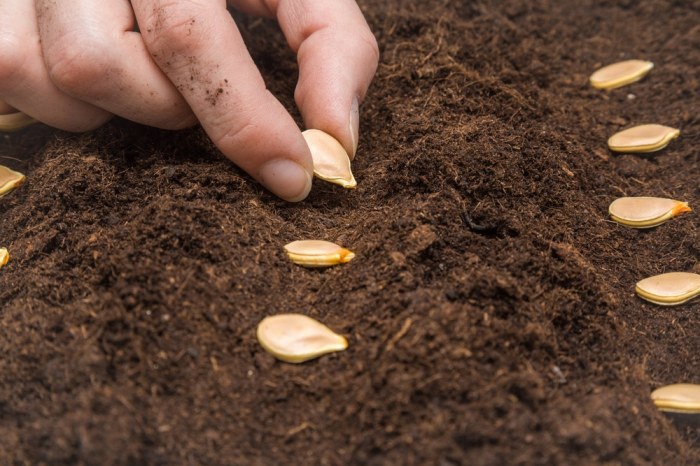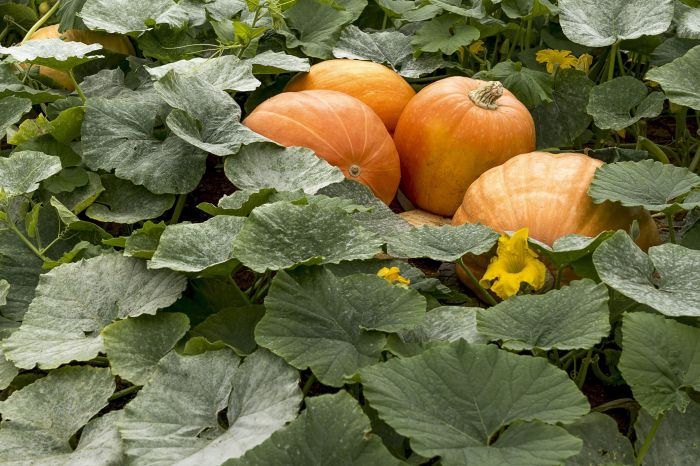How and When Do You Plant Pumpkin Seeds?
Ideal Timing for Planting Pumpkin Seeds
How and when do you plant pumpkin seeds – The optimal time to plant pumpkin seeds hinges on your geographical location and the prevailing climate. Understanding the impact of frost and aligning planting with your region’s growing season is crucial for successful pumpkin cultivation. Later planting times may result in a shorter growing season and smaller pumpkins. Early planting, however, risks frost damage.
Frost’s Impact on Pumpkin Growth
Frost is detrimental to pumpkin seedlings. A light frost can severely damage or kill young plants, hindering germination and subsequent growth. Therefore, it’s vital to wait until all danger of frost has passed in your area before planting pumpkin seeds directly outdoors. The average last frost date for your region is a key factor in determining the ideal planting time.
Pumpkin Planting Times by Variety and Region
Planting times vary based on pumpkin variety and geographic location (North and South representing general climate zones, adjust based on your specific USDA hardiness zone). Days to maturity are approximate and can be influenced by growing conditions.
| Variety | Planting Time (North) | Planting Time (South) | Days to Maturity |
|---|---|---|---|
| Connecticut Field | Late May – Early June | April – May | 90-100 |
| Howden Biggie | Late May – Early June | April – May | 100-110 |
| Jack o’Lantern | Late May – Early June | April – May | 95-105 |
| Baby Boo | Late May – Early June | April – May | 85-95 |
Preparing the Soil for Pumpkin Seeds
Pumpkins thrive in well-drained, fertile soil with a slightly acidic to neutral pH. Amending poor soil is crucial for optimal growth and yield. Adding organic matter improves soil structure, drainage, and nutrient content, leading to healthier and more productive plants.
Ideal Soil Conditions and Amendments

Source: garden.eco
The ideal soil pH for pumpkins ranges from 6.0 to 6.8. Poorly draining soil should be amended with compost, peat moss, or other organic materials to improve drainage and aeration. Sandy soils benefit from the addition of organic matter to increase water retention. Clay soils can be improved by adding compost and sand to improve drainage and aeration. A soil test can help determine the specific needs of your soil.
Step-by-Step Guide for Soil Preparation
- Clear the planting area of all weeds, rocks, and debris.
- Till the soil to a depth of 12-18 inches, breaking up any clumps.
- Incorporate 2-4 inches of compost or other well-rotted organic matter into the soil.
- Level the soil and rake it smooth.
Sowing Pumpkin Seeds: Methods and Techniques
Pumpkin seeds can be sown directly into the ground or started indoors. Direct sowing is simpler, while starting seeds indoors provides a head start, particularly in cooler climates. Both methods have their advantages and disadvantages. Proper seed depth and spacing are crucial regardless of the method chosen.
Direct Sowing vs. Starting Indoors
Direct sowing is suitable for warmer climates and involves planting seeds directly into the prepared soil. Starting seeds indoors is beneficial in cooler regions or for extending the growing season, allowing seedlings to establish before transplanting outdoors. This method requires more upfront effort but can result in earlier harvests.
Direct Sowing Technique
Plant seeds 1-2 inches deep and 4-6 feet apart. Space multiple seeds per hill (3-4 seeds) to account for potential germination failures, thinning later to the strongest seedling. Gently cover the seeds with soil and water thoroughly.
Starting Seeds Indoors
Plant seeds in individual peat pots or seed trays filled with seed-starting mix. Keep the soil moist and warm (70-80°F). Once seedlings develop their first true leaves, they can be transplanted outdoors.
Optimal Spacing Between Pumpkin Plants
A visual representation of ideal spacing: Imagine a grid with each plant occupying a square of approximately 4-6 feet. This allows for sufficient space for vine growth and fruit development.
Pumpkin Seed Germination and Early Growth

Source: hearstapps.com
Successful pumpkin seed germination depends on adequate temperature, moisture, and light. Addressing common germination problems early on is essential for a bountiful harvest. Consistent watering during early growth stages is critical for healthy seedling development.
Conditions for Germination
Optimal soil temperature for germination is between 70-80°F. Maintain consistently moist soil, but avoid overwatering, which can lead to rot. While seedlings don’t require direct sunlight initially, adequate indirect light promotes healthy growth.
Common Germination Problems and Solutions
- Problem: Seed rot. Solution: Ensure good soil drainage and avoid overwatering.
- Problem: Slow germination. Solution: Check soil temperature and moisture levels. Consider using a heat mat.
- Problem: Seedling damping-off. Solution: Ensure good air circulation and avoid overhead watering.
Challenges During Early Growth and Solutions
- Problem: Pests (e.g., slugs, aphids). Solution: Use appropriate pest control methods.
- Problem: Weed competition. Solution: Regularly weed around the plants.
- Problem: Nutrient deficiencies. Solution: Conduct a soil test and amend accordingly.
Caring for Pumpkin Plants After Germination
Ongoing care throughout the growing season is vital for maximizing pumpkin yield and quality. This includes regular watering, fertilization, pest control, and vine support. Recognizing and addressing nutrient deficiencies promptly is crucial for healthy plant growth.
Watering, Fertilization, and Pest Control
Water deeply and regularly, especially during dry periods. Fertilize with a balanced fertilizer according to package instructions. Monitor for pests and diseases and implement appropriate control measures. Regular inspection is crucial for early detection and intervention.
Supporting Pumpkin Vine Growth
For larger varieties, consider trellising to support the heavy vines and fruit. For smaller varieties, ground cover may suffice. Adequate support prevents vines from rotting and ensures even fruit development.
Nutrient Deficiency Signs and Solutions, How and when do you plant pumpkin seeds
Nutrient deficiencies manifest in various ways. Yellowing leaves might indicate nitrogen deficiency, while purplish leaves may suggest phosphorus deficiency. A soil test helps identify specific deficiencies, allowing for targeted amendment.
Pumpkin Plant Care Checklist
A checklist should be tailored to your specific climate and variety, but should include regular watering, fertilization according to need, pest monitoring, and vine support.
Pumpkin Varieties and Their Planting Needs
Numerous pumpkin varieties exist, each with specific planting requirements and characteristics. Selecting a variety suited to your climate and growing conditions is key to a successful harvest. Consider factors like size, shape, color, and growing season length when choosing a variety.
Examples of Pumpkin Varieties
Examples include Connecticut Field (large, classic jack-o’-lantern type), Howden Biggie (another large variety), Jack o’Lantern (smaller, classic Halloween pumpkin), and Baby Boo (small, white pumpkins). Each variety has slightly different planting needs in terms of spacing, soil preference, and sunlight exposure.
Planting Requirements for Different Pumpkin Types
Spacing requirements vary between varieties, with larger pumpkins requiring more space than smaller ones. Soil requirements generally remain consistent across most varieties, focusing on well-drained, fertile soil. Sunlight needs are similar across most varieties; at least 6-8 hours of direct sunlight per day.
Characteristics of Pumpkin Varieties

Source: minnetonkaorchards.com
Pumpkin varieties differ significantly in size, shape, and color. Some are large and round, suitable for carving, while others are smaller and more compact, ideal for baking or decorating.
FAQ Corner: How And When Do You Plant Pumpkin Seeds
What type of fertilizer is best for pumpkins?
Pumpkin seeds should be planted after the last frost, ideally in well-drained soil. The process is fairly straightforward, but if you’re curious about the intricacies of virtual gardening, you might find the guide on don’t starve how to plant seeds helpful. Understanding the basics of seed planting translates well across different contexts, whether it’s your backyard or a digital world.
Remember to ensure sufficient sunlight for optimal pumpkin growth.
A balanced fertilizer (like a 10-10-10) is a good starting point. However, pumpkin plants benefit from higher potassium levels later in the season to support fruit development.
How often should I water my pumpkin plants?
Water deeply and regularly, especially during dry spells. Aim for consistently moist soil, but avoid overwatering which can lead to root rot.
What are some common pumpkin pests and diseases?
Common pests include squash bugs, aphids, and vine borers. Diseases to watch out for include powdery mildew and downy mildew. Regular inspection and prompt treatment are crucial.
Can I save pumpkin seeds from my harvest to plant next year?
Yes, but ensure you select seeds from healthy, mature pumpkins. Clean and dry the seeds thoroughly before storing them in a cool, dry place.





















